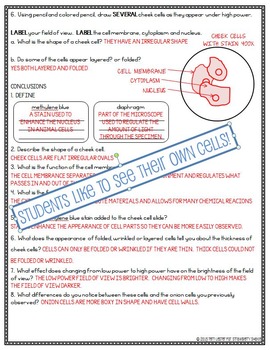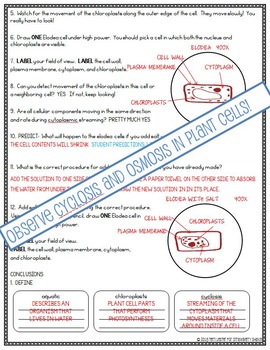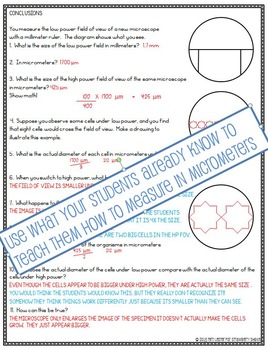Biology Lab MICROSCOPE Labs that Develop SKILLS: Staining, Measuring and more
Strawberry Shake
1.9k Followers
Grade Levels
5th - 12th
Subjects
Resource Type
Formats Included
- PDF
Pages
50 pages
Strawberry Shake
1.9k Followers
What educators are saying
I used this for an after school science club activity. I loved how many options we had, the kids loved it.
Description
Learning how to use the compound light microscope is an important part of any life science or biology course. Students enjoy looking at things they cannot see with their own eyes. It's easy to learn how to use the microscope, but there are lots of little aspects that the students may not realize by just learning all the parts and their functions.
In this series of lab activities, the students use their own microscope skills to observe many different living and non-living specimens including protists, plant cells and animal cells - including their own human specimens!
Students will practice the techniques for making and staining wet mount slides. They will learn aspects of resolution, magnification and depth of field, and how to measure the size of a microscopic specimen in micrometers.
You will not be disappointed in the variety and quality of these teaching materials that have been tried and perfected with my own students throughout my 25 year career in teaching biology.
INCLUDES:
1. VARYING POWERS - simply outlined observation sheets. Look at one specimen under different objectives to see the difference in magnification.
2. POND WATER - simply outlined observation sheets for pond water slides or another specimen of your choice.
3. OBSERVING CORK CELLS – see what HOOKE saw!
4. PREPARING A WET MOUNT SLIDE – the classic letter e lab in an updated format with an appealing layout.
5. RESOLVING POWER and DEPTH or FIELD – two investigations that show the meaning of these terms
6. MEASURING WITH THE MICROSCOPE – uses estimating skills students already have in a way they’ll understand both relative size and actual size of specimens.
7. USING STAINS TO AID OBSERVATION – teaches students how to correctly apply a solution to a wet mount slide. Reviews plant cell structure.
8. OBSERVING HUMAN CHEEK CELLS – Students love to see their own cells!
9. OBSERVING ELODEA – Also called anacharis, this water plant allows students to observe cyclosis. Also introduces the effect of a salty environment.
10. OSMOSIS IN RED ONION CELLS – the culmination of our microscope study. Concepts include: making a wet mount, adding a solution to a slide, focusing under low power and high power, making good drawings, and observing the cell process of osmosis.
This product is a part of my ULTIMATE MICROSCOPE BUNDLE that includes everything you'll ever need to teach about the microscope. Help your students learn how to use the microscope to observe plant and animal specimens with this HUGE bundle of resources. Save TIME, save MONEY, and still benefit from an abundance of tried and tested experiments and activities. In the complete bundle you get 140 pages full of resources, worksheets, printables, diagrams, photographs, posters, advice and study tools. You will not be disappointed in the quality and the quantity of material this purchase provides.
MICROSCOPE Vintage Posters © 2015 Terri Lester for Strawberry Shake.
All rights reserved. Purchase of this unit entitles the purchaser the right to reproduce the pages in limited quantities for classroom use only. Duplication for an entire school, an entire school system or commercial purposes is strictly forbidden without written permission from the publisher.
Copying any part of this product and placing it on the Internet in any form (even a personal/classroom website) is strictly forbidden and is a violation of the Digital Millennium Copyright Act (DMCA).
Here are some other products you might like:
FREE GRAPHING PRACTICE Heart Rate Studies
FROG DISSECTION Teacher Guide and Student Packet
DNA FINGERPRINTING Using Gel Electrophoresis to Solve a Crime
DIFFUSION Using Indicators to Investigate
GENETICS TASK CARDS
ECOLOGY TASK CARDS
DIFFUSION AND OSMOSIS TASK CARDS
BIOLOGY GRAPHING PRACTICE: Photosynthesis - Wavelengths of Light
BIOLOGY GRAPHING Effect of Salt on Daphnia
Modeling Photosynthesis - Visualize Chloroplasts in Action
Non-Fiction Reading: Alien Invaders - the GYPSY MOTH
Photosynthesis Test Bank - 100 Editable Multiple Choice Questions
In this series of lab activities, the students use their own microscope skills to observe many different living and non-living specimens including protists, plant cells and animal cells - including their own human specimens!
Students will practice the techniques for making and staining wet mount slides. They will learn aspects of resolution, magnification and depth of field, and how to measure the size of a microscopic specimen in micrometers.
You will not be disappointed in the variety and quality of these teaching materials that have been tried and perfected with my own students throughout my 25 year career in teaching biology.
INCLUDES:
1. VARYING POWERS - simply outlined observation sheets. Look at one specimen under different objectives to see the difference in magnification.
2. POND WATER - simply outlined observation sheets for pond water slides or another specimen of your choice.
3. OBSERVING CORK CELLS – see what HOOKE saw!
4. PREPARING A WET MOUNT SLIDE – the classic letter e lab in an updated format with an appealing layout.
5. RESOLVING POWER and DEPTH or FIELD – two investigations that show the meaning of these terms
6. MEASURING WITH THE MICROSCOPE – uses estimating skills students already have in a way they’ll understand both relative size and actual size of specimens.
7. USING STAINS TO AID OBSERVATION – teaches students how to correctly apply a solution to a wet mount slide. Reviews plant cell structure.
8. OBSERVING HUMAN CHEEK CELLS – Students love to see their own cells!
9. OBSERVING ELODEA – Also called anacharis, this water plant allows students to observe cyclosis. Also introduces the effect of a salty environment.
10. OSMOSIS IN RED ONION CELLS – the culmination of our microscope study. Concepts include: making a wet mount, adding a solution to a slide, focusing under low power and high power, making good drawings, and observing the cell process of osmosis.
This product is a part of my ULTIMATE MICROSCOPE BUNDLE that includes everything you'll ever need to teach about the microscope. Help your students learn how to use the microscope to observe plant and animal specimens with this HUGE bundle of resources. Save TIME, save MONEY, and still benefit from an abundance of tried and tested experiments and activities. In the complete bundle you get 140 pages full of resources, worksheets, printables, diagrams, photographs, posters, advice and study tools. You will not be disappointed in the quality and the quantity of material this purchase provides.
MICROSCOPE Vintage Posters © 2015 Terri Lester for Strawberry Shake.
All rights reserved. Purchase of this unit entitles the purchaser the right to reproduce the pages in limited quantities for classroom use only. Duplication for an entire school, an entire school system or commercial purposes is strictly forbidden without written permission from the publisher.
Copying any part of this product and placing it on the Internet in any form (even a personal/classroom website) is strictly forbidden and is a violation of the Digital Millennium Copyright Act (DMCA).
Here are some other products you might like:
FREE GRAPHING PRACTICE Heart Rate Studies
FROG DISSECTION Teacher Guide and Student Packet
DNA FINGERPRINTING Using Gel Electrophoresis to Solve a Crime
DIFFUSION Using Indicators to Investigate
GENETICS TASK CARDS
ECOLOGY TASK CARDS
DIFFUSION AND OSMOSIS TASK CARDS
BIOLOGY GRAPHING PRACTICE: Photosynthesis - Wavelengths of Light
BIOLOGY GRAPHING Effect of Salt on Daphnia
Modeling Photosynthesis - Visualize Chloroplasts in Action
Non-Fiction Reading: Alien Invaders - the GYPSY MOTH
Photosynthesis Test Bank - 100 Editable Multiple Choice Questions
Total Pages
50 pages
Answer Key
Not Included
Teaching Duration
N/A
Report this resource to TPT
Reported resources will be reviewed by our team. Report this resource to let us know if this resource violates TPT’s content guidelines.





